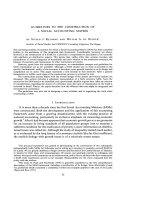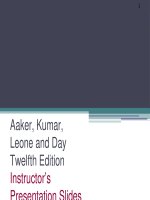Lecture Accounting principles (8th edition) – Chapter 21: Process cost accounting
Bạn đang xem bản rút gọn của tài liệu. Xem và tải ngay bản đầy đủ của tài liệu tại đây (1.39 MB, 52 trang )
Chapter
21-1
CHAPTER 21
PROCESS COST
ACCOUNTING
Accounting Principles, Eighth Edition
Chapter
21-2
Study Objectives
Study Objectives
1.
Understand who uses process cost systems.
2.
Explain the similarities and differences between job order and
process cost systems.
3.
Explain the flow of costs in a process cost system.
4.
Make the journal entries to assign manufacturing costs in a
process cost system.
Chapter
21-3
Study Objectives
Study Objectives
Chapter
21-4
5.
Compute equivalent units.
6.
Explain the four steps necessary to prepare
a production cost report.
7.
Prepare a production cost report.
8.
Explain justintime (JIT) processing.
9.
Explain activitybased costing (ABC).
Preview of Chapter
Preview of Chapter
Process cost accounting focuses on
massproduction of products that
are identical or very similar in
nature.
In contrast, job order cost
accounting focuses on the
individual job.
Chapter
21-5
Process Cost Accounting
Process Cost Accounting
Nature
Natureof
of
Process
ProcessCost
Cost
Systems
Systems
Uses
Similarities and
Differences
Process Cost Flow
Assignment of
Manufacturing
Costs
Equivalent
Equivalent
Units
Units
WeightedAverage Method
Refinements
Production Cost
Report
Comprehensive
Comprehensive
Example
Exampleof
of
Process
Process
Costing
Costing
Physical Units
Equivalent Units of
Production
Unit Production Costs
Cost Reconciliation
Schedule
Production Cost Report
Costing Systems –
Final Comment
Chapter
21-6
Contemporary
Contemporary
Developments
Developments
Just-in-Time
Processing
Activity-Based
Costing
Nature of Process Cost Systems
Nature of Process Cost Systems
Use to apply costs to similar products that are
massed produced in a continuous fashion
Examples include the production of
Cereal, Paint, and Soft Drinks
Chapter
21-7
LO 1: Understand who uses process cost systems.
Comparison of Products Produced
Comparison of Products Produced
Under Process and Job Order Cost Systems
Under Process and Job Order Cost Systems
Chapter
21-8
LO 1: Understand who uses process cost systems.
Let’s Review
Let’s Review
Which of the following items is not a characteristic of a process cost
system:
a.
Once production begins, it continues until the finished product
emerges.
emerges
b. The focus is on continually producing homogenous products.
c. When the finished product emerges, all units have precisely the
same amount of materials, labor, and overhead.
d. The products produced are heterogenous in nature.
Chapter
21-9
LO 1: Understand who uses process cost systems.
Job Order Cost and Process Cost Flow
Job Order Cost and Process Cost Flow
Job Order Cost Systems
Chapter
21-10
Process Cost Systems
Costs are assigned to each job.
Costs are tracked through a series of
connected manufacturing processes or
departments.
Products have unique characteristics.
Products are uniform or relatively
homogeneous and produced in a large
volume.
LO 2: Explain the similarities and differences between job order cost
and process cost systems
Job Order Cost vs Process Cost Flow
Job Order Cost vs Process Cost Flow
Chapter
21-11
LO 2: Explain the similarities and differences between job order cost
and process cost systems.
Similarities and Differences in Cost Systems
Similarities and Differences in Cost Systems
Similarities
The accumulation of costs is the same in both systems.
Both costing systems track the three manufacturing
cost elements: direct materials, direct labor, and
manufacturing overhead.
Costs are assigned to the same general ledger accounts in both
costing systems.
However, the methods of assigning the costs
differ significantly.
Chapter
21-12
LO 2: Explain the similarities and differences between job order cost
and process cost systems.
Similarities and Differences in Cost Systems
Similarities and Differences in Cost Systems
Differences
The number of work in process accounts
Job Order one work in process account
Process multiple work in process accounts
Documents used to track costs
Job Order job cost sheets
Process production cost reports
Chapter
21-13
LO 2: Explain the similarities and differences between job order and
process cost systems.
Similarities and Differences in Cost Systems
Similarities and Differences in Cost Systems
Differences
The point at which costs are totaled
Job Order – when job is completed
Process at end of period of time
Unit cost computation
Job Order – total cost per job divided by units
in job
Process – total manufacturing costs for the
period divided by units
produced during the period
Chapter
21-14
LO 2: Explain the similarities and differences between job order and
process cost systems.
Major Differences Between Job Order and Process Cost
Major Differences Between Job Order and Process Cost
Systems
Systems
Chapter
21-15
LO 2: Explain the similarities and differences between job order and
process cost systems.
Let’s Review
Let’s Review
Indicate which of the following statements is not correct:
a.
Both a job order and a process cost system track the same three
manufacturing cost elements – direct materials, direct labor, and
manufacturing overhead.
b.
In a job order cost system, only one work in process account is used, whereas
in a process cost system, multiple work in process accounts are used..
c.
Manufacturing costs are accumulated the same way in a job order and in a
process cost system.
d.
Manufacturing costs are assigned the same way in a job order and in a
process cost system.
Chapter
21-16
LO 2: Explain the similarities and differences between job order cost
and process cost systems.
Process Cost Flows Illustrated
Process Cost Flows Illustrated
Example – Tyler Company
Maker of automatic can openers
Manufacturing consists of two processes:
Machining – raw materials are shaped, honed,
and drilled
Assembly – parts assembled and packaged
Materials, labor, and manufacturing overhead added in both
departments
Chapter
21-17
LO 3: Explain the flow of costs in a process cost system.
Process Cost Flows Illustrated
Process Cost Flows Illustrated
Example – Tyler Company
Chapter
21-18
LO 3: Explain the flow of costs in a process cost system.
Assignment of Manufacturing Costs
Assignment of Manufacturing Costs
Accumulation of materials, labor, and overhead costs is same as
in job order costing
Debit Raw Materials Inventory for
purchases of raw materials
Debit Factory Labor for factory labor
incurred
Debit Manufacturing Overhead for overhead
cost incurred
However, assignment of the three manufacturing cost elements to
Work in Process is different
Chapter
21-19
LO 3: Explain the flow of costs in a process cost system.
Assignment of Manufacturing Costs
Assignment of Manufacturing Costs
Materials
A process cost system requires fewer material requisition slips than
a job order cost system
Materials are used for processes and not specific jobs
Requisitions are for larger quantities of materials
The journal entry to record materials used:
Chapter
21-20
LO 4: Make the journal entries to assign manufacturing costs in a process
cost system.
Assignment of Manufacturing Costs
Assignment of Manufacturing Costs
Factory Labor Costs
Time tickets are used in both systems
All labor costs incurred within
a production department are
a cost of processing.
The journal entry to record factory labor costs:
Chapter
21-21
LO 4: Make the journal entries to assign manufacturing costs in a process
cost system.
Assignment of Manufacturing Costs
Assignment of Manufacturing Costs
Manufacturing Overhead Costs
Objective of assigning overhead –
allocate overhead to departments on an
objective and equitable basis
Use the activity that “drives”
or causes the costs
Machine time used
primary driver in continuous manufacturing operations
Chapter
21-22
LO 4: Make the journal entries to assign manufacturing costs in a process
cost system.
Assignment of Manufacturing Costs
Assignment of Manufacturing Costs
Manufacturing Overhead Costs
The entry to allocate overhead to the two
Chapter
21-23
processes is:
LO 4: Make the journal entries to assign manufacturing costs in a process cost
system.
Assignment of Manufacturing Costs
Assignment of Manufacturing Costs
Entries to Transfer Costs Through System
Monthly Entry to transfer goods to next department:
Entry to transfer completed goods to Finished Goods:
Entry to record Cost of Goods sold at the time of sale:
Chapter
21-24
LO 4: Make the journal entries to assign manufacturing costs in a process cost
system.
Let’s Review
Let’s Review
In making the journal entry to assign raw materials costs:
a.
The debit is to Finished goods Inventory.
The debit is to Finished goods Inventory
b. The debit is often to two or more work in process
accounts.
c. The credit is generally to two or more work in process
accounts.
d. The credit is to Finished Goods Inventory.
Chapter
21-25
LO 4: Make the journal entries to assign manufacturing costs in a process
cost system.









